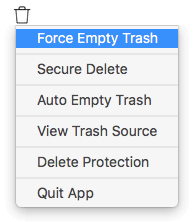

All these attached bins, including Gmail, can be emptied at once, using a module in a handy app called CleanMyMac X. Also, when you use a Gmail account in Mail or any other email client, messages you delete remain in a folder on your Mac. Disconnecting the drive doesn’t empty the Trash, and so it continues to take up space. Each hard drive or SSD you have connected has its own Trash. How to automatically force empty Trash on Mac The message can also pop up if you try to delete any other file protected by SIP. Time Machine backup files are protected by SIP, so if you try to drag them to the Trash and empty it, you may see the error message. The ‘Some items in the trash cannot be deleted’ error message most commonly appears when you manually delete Time Machine backups. That meant that if you downloaded malware and it gained root user status, it could do anything it wanted.įollowing the introduction of SIP, many applications and utilities that needed access to mission-critical files had to be modified so that they continued to work in a post-SIP world.
:max_bytes(150000):strip_icc()/how-to-check-storage-on-mac-509234710-7fe5ade2863b41b89bd989dde36e530e.jpg)
Before the introduction of SIP, anyone or any process with root access could alter or delete any file on your Mac.

It prevents the root user from modifying or deleting those files. System Integrity Protection (SIP) was introduced in macOS El Capitan as an extra layer of security for critical files on your Mac. We’ll also show you how you can override the error message and force empty the Trash. There’s a very good reason that macOS won’t delete these files, as we’ll explain in this article. That means that macOS won’t delete the files in question, and they will remain in the Trash until you move them out. Occasionally, when you empty the Trash on your Mac, you may see the message ‘Some items in the Trash cannot be deleted because of System Integrity Protection’. But to help you do it all by yourself, we’ve gathered our best ideas and solutions below.įeatures described in this article refer to the MacPaw site version of CleanMyMac X. So here’s a tip for you: Download CleanMyMac to quickly solve some of the issues mentioned in this article.


 0 kommentar(er)
0 kommentar(er)
